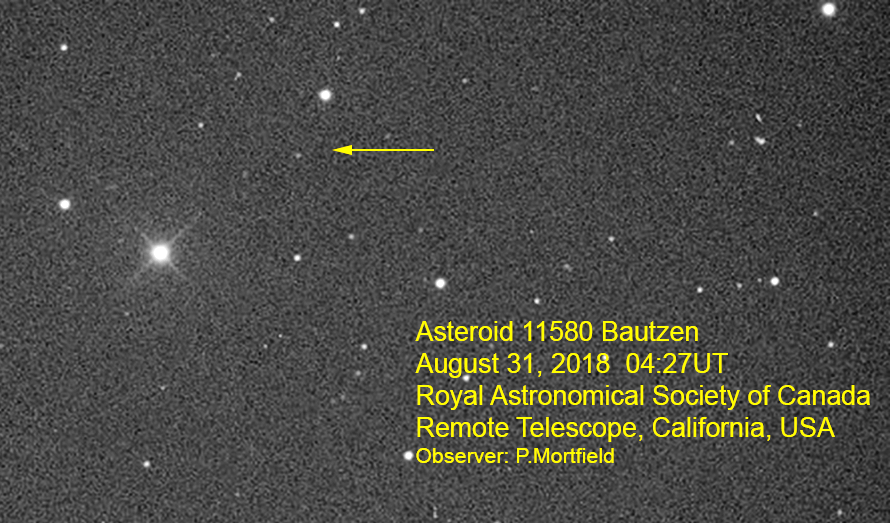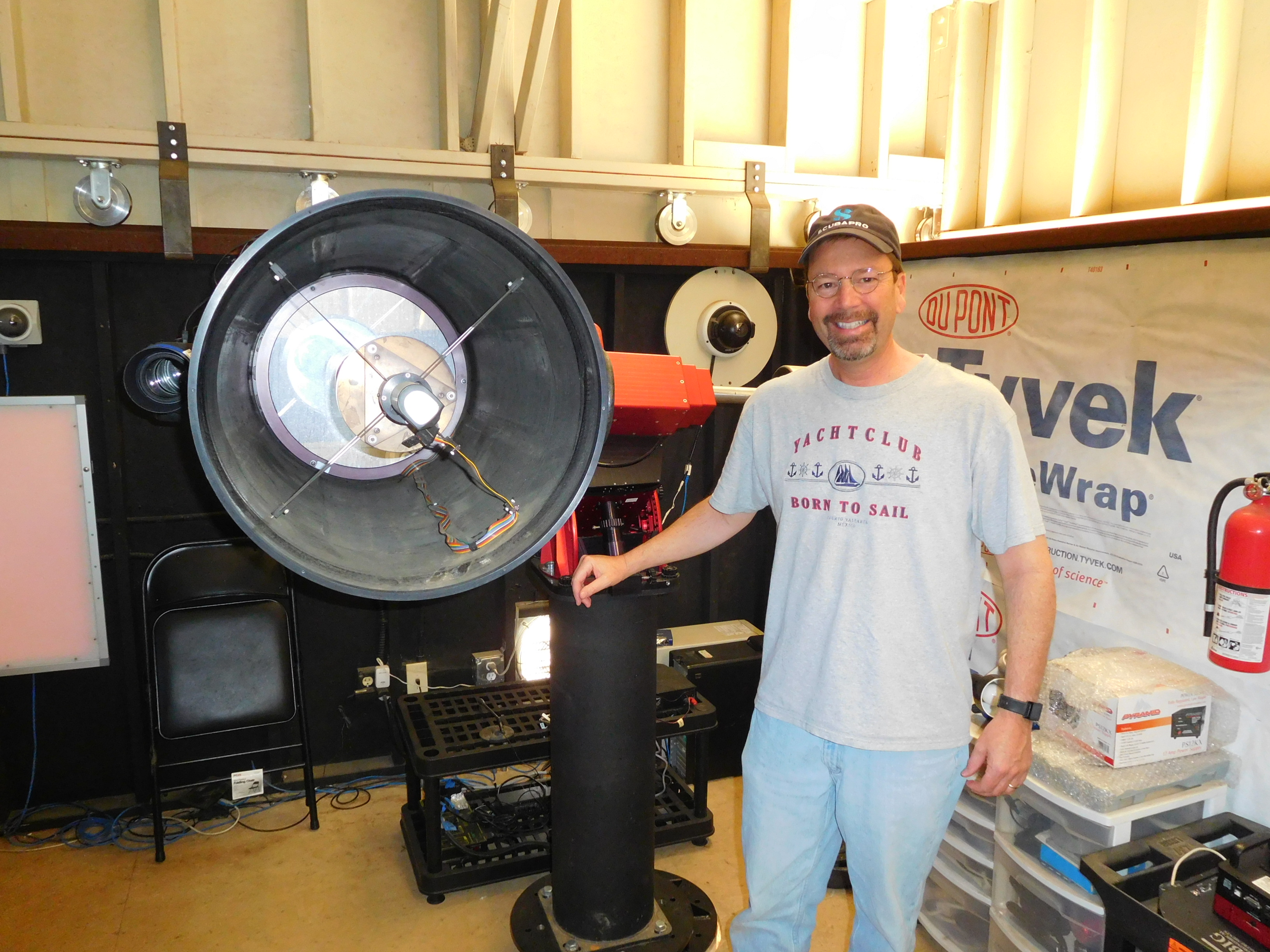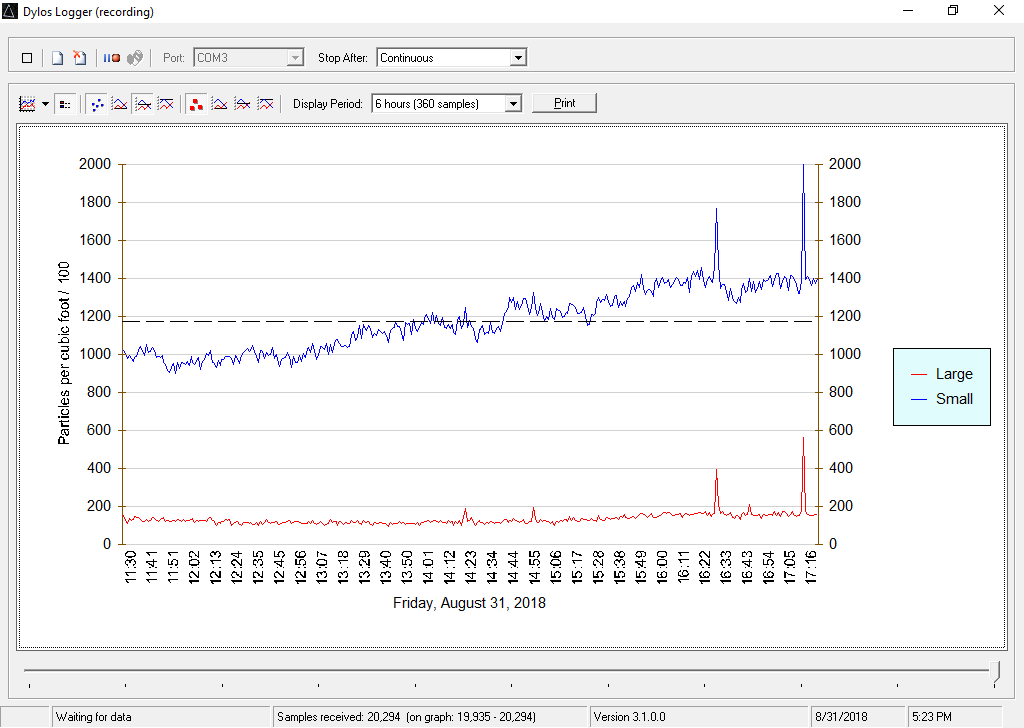2018-08-31 Hunting for Asteroids
We've all heard how a rogue asteroid smashed into the Earth near the Yucatan Peninsula, and wiped out the dinosaurs. In happier news, the RASC, the Burke-Gaffney Observatory at St. Mary's University in Halifax, and Pan-STARRS observatory in Hawaii received an interesting request on August 26th. The idea was to attempt an image of Asteroid (11580) Bautzen, as it was near opposition, when it would be detectable due to being better lit by the Sun. SMU's Dave Lane calculated it would likely be too close to the moon, and difficult to detect.
We decided to attempt this challenge with the RASC Robotic Observatory in California, and you can see the result below.

Paul used the new CCD Camera and a Hydrogen Alpha filter to block out most of the moon's glare.
We were pleased to hear the Pan-STARRS survey telescope also captured an image, on the 26th.
2018-08-30 Planning Meeting
We held a 2-hour planning meeting in Vaughan, Ontario, on Thursday evening to discuss current state of the project and immediate next steps. Executive director Randy Attwood will be sending an update out in the next newsletter to members.
We touched on the remaining technical activities and science-related activities as well as astrophotography ideas, and the challenges of managing all the data that the system can produce and how best to share it. We'll be working through many of these ideas and issues over the next few weeks.
2018-08-22 Planned Down Time
We receive timely and advanced notice of any work planned at SRO so that we can adkust our activities or suspend the scheduled work for the telescope. Mel Helm let us know about some upgrades that they would be doing over the next few days.
Jim Goetz took this nice picture of Mel beside our telescope.

The time around full-moon is always best for everyone to schedule updates, maintenance, and other work, as the bright night sky isn't ideal for capturing images of faint objects. We have to plan around the moon for many of our activities.
2018-08-15 Telescope Performance
How much work can the telescope do? What can we expect? This depends on the type of task. Deep sky images take a lot longer than a hanful of shots to look for a specific asteroid. The exposure times are different, but there are "overhead" steps that must be done for any image.There's a limit to how much the telescope can do. We need to understand what is possible and what is practical.
Getting a single image involves these steps, and each step takes time. Here are some factors that go into it:
- Time to slew to the target - can be up to about 120 seconds
- Focus Adjustment - could be 30 seconds or more. We need to test this out. Not needed for every image
- Rotate to desired position angle - perhaps 30 seconds.
- Select desired filter - perhaps 5 seconds
- Take initial image - 30 second exposure, 2 second digitization, 10 second download = 42s
- Plate solve to verify pointing - 3 seconds
- Start guiding - 5 seconds
- Take image - for some objects, 30 minutes = 1800 seconds + 2 + 10 = 1812 seconds
- Plate solve and save - 3 seconds
Total: 2050 seconds, or about 34 minutes. That's about 250 seconds (4 minutes) lost to do the "overhead".
To do a tri-colour image, we have to do two more images and two more filter changes. Each filter change could potentially require a small focus adjustment. Exposures are often longer on certain filters. So, a total of 2-3 hours or more. A high quality deep sky image can easily take 20 hours of telescope time.
We will need to work on optimizing the performance of the telescope once we better understand how long steps typically take. We can do this once we start getting real data, and start examining the logs. Reducing the overhead will help us get more images in a given night.
2018-08-10 Twenty Days of Continuous Testing and No Sleepless Nights
Automation testing ran for 20 days. We gave ACP Scheduler control of the telescope on July 21, and began monitoring for any issues. Each night, ACP Scheduler would go through its nightly routine, subject to the weather/smoke/roof status. It would happily report:

The Dispatcher is the part of the scheduler that figures out what to do and when. This includes figuring out the eligibility of a plan. Plans are used to determine what target you want to observe, and the details of the image set, which filters to use and how long an exposure. Criteria can include things like seeing conditions, proximity to the meridian (eg it is high over head), moonlight, and so on. We had a small handful of objects scheduled, and when we remembered to submit the observing plan, scheduler startup, review the eligible plans, and the Dispatcher would send the activity to be run.
A few issues did pop up in the logs, and happily the telescope successfully shut down every time without any manual intervention. We never needed to reboot anything or get out of bed.
2018-08-08 New MaxIm DL Pro 6.18 released
Our sponsor Diffraction Limited released a new update to their MaxIm DL software, enhancing its capabilities. We've decided to evaluate the new release and to monitor the Diffraction forums to assess if there is any risk to installing te new software. Initial reports are good, and my local installation went smoothly. We'll decide when to update the production system, and feel it's best to be conservative with any updates or introducing any changes to the system.
2018-08-03 Smoke Detection Initiative
Smoke from the nearby forest fires continue to be an issue. SRO purchased and installed a laser particle detector. This device shines laser light through the air, and can differentiate between large particles from pollen and smaller particles from smoke. They are adding this to determine if it is safe to open up the roof of the buildings A sample graph from the particle detector is shown below.

2018-08-02 Connecting the CCD Camera
The new CCD Camera includes the filter wheel, a self-guider ahead of the filters so that it does not receive filtered light, and an AO-X adaptive optics unit to take some of the shimmer out of the stars. This means that there is less distance between the front of the camera and the Preciision Instrument Rotator (PIR) on the back of the telescope. A custom adapter has been ordered from Precise Parts to solve this. It will be several days before the new part arrives. This is one of those items that you can't totally anticipate in advance.
